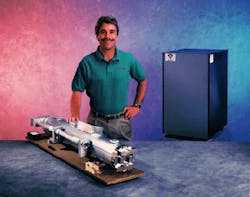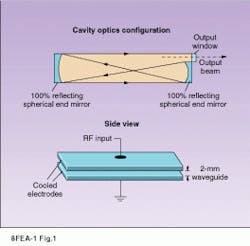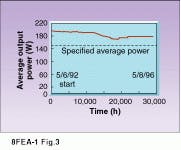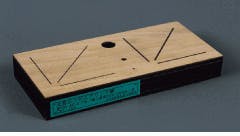Sealed carbon dioxide lasers achieve new power levels
KURT BONDELIE
Carbon dioxide (CO2) lasers have long been the standard for industrial lasers. With output powers from a few watts up to 50 kW, these lasers are used for diverse applications ranging from packaging microelectronics to cutting and welding thick steel plate. Given the apparent maturity of the CO2 laser and the recent emergence of all-solid-state industrial lasers with output powers approaching 100 W, one might expect the market for low-power (less than 100-W) CO2 lasers to be showing signs of decline. The opposite is actually happening—these lasers represent one of the fastest growing segments of the industrial laser market (see Laser Focus World, January 1996, p. 50), and recent increases in the output power of sealed CO2 lasers are opening up new applications.
Sealed-tube CO2 lasers
Sealed CO2 lasers with output powers of a few watts were developed at Hughes Research (Malibu, CA) around 1977. Although these lasers have now been commercially available for almost 20 years, significant market growth for them has occurred only within the last five to seven years as prices have fallen and reliability has improved.
Compared to other industrial lasers such as flowing-gas CO2 lasers and lamp-pumped Nd:YAG systems, sealed-tube CO2 devices provide advantages of smaller size, simplicity, and lower operating costs. Unlike flowing-gas units, a sealed CO2 laser does not occupy cubic yards of space or require gas bottles and circulating pumps. Such a laser is compact enough to be used as a specialized tool for mounting on a robot arm or CNC (computerized numerical control) machine. Such benefits are important for large-area cutting or where factory space is at a premium (such as in Japan); a 4 × 4-ft moving-table cutter needs 64 ft2 of floor space whereas a moving-gantry cutter needs only 16 ft2.
Power output of the early sealed CO2 lasers was limited to tens of watts, their reliability was poor, and gas lifetimes were relatively short. These drawbacks were unacceptable in high-throughput manufacturing applications such as machining sheet metals and ceramics. This situation has now changed, with sealed CO2 lasers delivering 20,000-25,000 h of specified performance without any service to the laser head. Equally important, output powers have broken through the 100-W barrier, and the latest models deliver up to 500 W of continuous output power—or 1.5 kW pulsed—from a package measuring just 11 × 9.5 × 47 in. and weighing 135 lb.
Slab discharge: scaling to higher power
Obtaining an output power of 500 W from a small package requires a novel approach to laser design. In a typical gas laser the output power is linearly proportional to the discharge-tube length—the longer the path through the gain medium, the higher the power. Hence, with low-gain media—such as helium-neon—lasers producing watt-level output are impractical because of the long plasma tube that would be required.
A typical sealed CO2 plasma tube with radio-frequency (RF) excitation produces an output power of about 40 W/m of tube length. Higher output cannot be obtained by increasing the plasma diameter because efficient laser operation depends on contact between the excited gas and the cavity walls in order to cool the plasma—which is why the bore diameter of these lasers is only a few millimeters. In fact, laser designers used to believe that the only way to generate hundreds of watts from a compact package was to stack several lasers in a single box and combine the output beams or to use a multifolded "Z" configuration. Both approaches have drawbacks, including complexity, poor mode quality, and potential misalignment.
Slab-discharge technology eliminates these problems and enables high output power to be produced independent of the length limitations of conventional gas-laser technology. In a slab design, the plasma discharge is confined by two rectangular plate electrodes.1-3 A 2-mm gap between these electrodes ensures efficient gas cooling and high gain.
Spherical cavity end mirrors of different radii of curvature ensure that the internal beam fills the entire slab-shaped plasma. One of the end mirrors does not fully extend to the edge of the electrodes so that part of the beam can exit the cavity (see Fig. 1). The main advantage of this design is that its output power is proportional to total electrode area and not to the cavity length. Furthermore, the scaling factor is very high (1 W/cm2).The slab-discharge design has been commercialized by Coherent and enables higher output power to be obtained from a given overall package size. The technology gives laser designers the freedom to scale up to higher powers by increasing the laser cavity width as well as its length. This design is also called a hybrid cavity because it functions as a waveguide along one axis (the 2-mm separation) and as an unstable resonator on the other.
The slab-discharge laser produces excellent far-field beam quality (M2 less than 1.2) that is actually superior to many conventional laser designs. The low M2 value translates directly to a tighter beam focus. The narrow-gap discharge also enables fast excitation and relaxation of the plasma, which the end-user experiences as fast-pulsing capability—that is, high repetition rates (up to 20 kHz) with square-shaped pulses. Because most of the energy in a square pulse is delivered above material-processing thresholds, little is wasted just heating the material, which is not the case for the relatively slow-risetime pulses from conventional-design CO2 lasers. A slab-discharge CO2 laser can deliver pulses with peak power around four times the rated average power, but the duty cycle can be smoothly varied up to 50%, thereby allowing many different materials and material thicknesses to be optimally processed.
At Coherent, we refer to the combination of a tightly focusable beam and high-power square pulses as Brilliance (see Fig. 2). This Brilliance factor allows the laser to process materials at two to three times the speed of a similarly rated conventional CO2 laser, depending on the thermal conductivity of the material involved. Brilliance also facilitates colder cutting with a smaller heat-affected zone.This year marks the advent of the first 500-W sealed laser (the model K500). This laser measures only 11 × 9.5 × 47 in. and weighs 135 lb (see photo at top of this page). It can be mounted directly over the worksurface on a CNC machine or robot arm, delivering pulses with peak power up to 1.5 kW.
Applications
Slab-technology CO2 lasers can be used in applications ranging from perforating carbonless paper at low powers to welding metal bellows and cutting sunroof openings in auto bodies at higher power. Two applications currently using this new tool exemplify the particular benefits of a 500-W output level; these are cutting slots in die boards and cutting and scribing ceramic substrates for surface-mount-technology (SMT) de vices in the electronics packaging industry.
A die board is a laminated wooden board in which many flexible metal blades or rules are inserted into pre-cut slots (see Fig. 4). This template is then used to stamp complex patterns from card or paper sheets—usually to be folded into cartons. Cut-slot widths vary between 1 and 5 points (one point is 0.014 in.)—in the USA most boards use 2-, 3-, or 4-point slots.Although motion systems could deliver 80 in./min. of raw material, US die-board cutting machines prefer a typical table speed of 20-25 in./min. Feed rate is limited by the need to preserve cut quality while cutting complex contours. A 225-W sealed CO2 laser could cut two-point slots in a single pass but only at a rate of 10-15 in./min. While multiple passes could be used, this is undesirable for two reasons. First, motion tolerances can lead to variations in slot width and thus loose rules. Second, using multiple passes slows productivity to an often unacceptable level.
The new 500-W laser should cut 2- and 3-point slots in a single pass, with feed rates of 25 in./min. or more for 2-point cuts in 7-ply maple. This performance is expected to finally open this large application to the benefits of compact laser technology. In some older die-board cutters, the flowing-gas laser system occupies as much space as the cutting machine itself.
In the case of cutting and scribing ceramic substrates for SMT devices, 100 W is a critical power level. The 150-W and 250-W lasers have already proven useful for this application. In operation, the laser is mounted above a ceramic sheet that is then moved rapidly on a high-precision programmable x, y motion table (typically 4 × 4 in.). With the 500-W laser, the laser beam is split into four identical beams in a 4 × 4-in. array. With this configuration not only can four identical substrates be cut from the same sheet at the same time, but 8 × 8-in. sheets can be worked without the higher cost of a 8 × 8-in programmable motion system. The result is higher throughput with lower manufacturing costs.
With their demonstrated longevity and reliability, sealed CO2 lasers can finally be considered as tools—and with powers up to 500 W, they can even be considered as high-speed machine tools. The reliability improvements have also eliminated the need for in-house service support—an important breakthrough for industrial users. The laser is designed for ease of refurbishment, and downtime is often less than that required to sharpen and replace other specialized industrial tools.
REFERENCES
1. S. Yatsiv, "Conductively cooled capacitively coupled RF excited CO2 lasers," in Gas Flow and Chemical Lasers, S. Rosenwaks, ed., Springer Verlag, Berlin (1986), p. 252.
2. P. E. Jackson, H. J. Baker, and D. R. Hall, Appl. Phys. Lett. 54, 1950 (1989).
3. J. Tulip, U.S. patent # 4,719,639.




